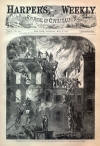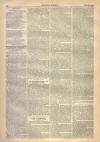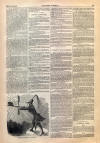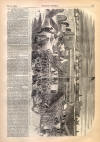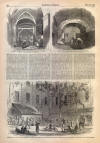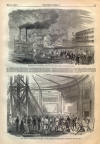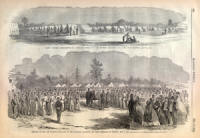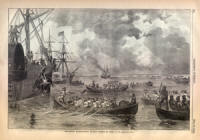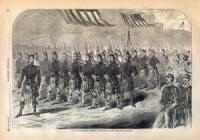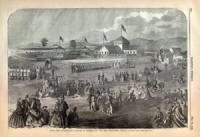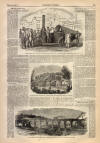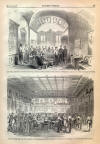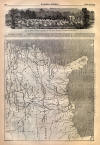Winans Steam Gun
|
|
This Site:
|
MAY 25, 1861.] HARPER'S WEEKLY. 331 WINANS STEAM GUN.WE herewith illustrate, from a photograph by Weaver, the celebrated STEAM GUN. patented by Mr. Dickinson, and made by Mr. Winans, of Baltimore. This gun was seized by Colonel Jones, of the Massachusetts Volunteers, when on its way from Baltimore to the Rebel Camp at Harper's Ferry, and is now used in protecting the VIADUCT AT THE WASHINGTON JUNCTION on the Baltimore Branch of the Baltimore and Ohio Railroad. We also publish herewith a view of the RELAY HOUSE, now occupied by the Federal Volunteers. This point commands the Baltimore and Ohio Road, being the point at which the road from Washington branches off on one side to Washington, on the other to Harper's Ferry and Wheeling. The merits of the steam gun are a matter of some controversy. We shall probably know ere long what it can do. The following is the statement of its principles by the inventor: ' As a triumph of inventive genius, in the application and practical demonstration of centrifugal force (that power which governs and controls the universe and regulates and impels the motion of planetary bodies round the sun), this most efficient engine stands without a parallel commanding wonder and admiration at the simplicity of its construction and the destructiveness of its effects; and is eventually destined to inaugurate a new era in the science of war. " Rendered ball proof, and protected by an iron cone, and mounted on a four-wheeled carriage, it can be readily moved from place to place or kept on march with an army. It can be constructed to discharge missiles of any capacity from an ounce ball to a twenty-four pound shot, with a . force and range equal to the most approved gunpowder projectiles, and can discharge from one hundred to five hundred balls per minute. "For city or harbor defense it would prove more efficient than the largest battery. For use on the battle-field (the musket calibre engine) would mow down opposing troops as the scythe mows standing grain; and in sea-fights, mounted on low-decked steamers, it would be capable of sinking any ordinary war-vessel. "In addition to the advantages of power, continuous action, and velocity of discharge, may be added economy, in cost of construction, in space, labor, and transportation, all of which would be small in comparison to the cost and working of batteries of cannon, and the equipment and management of a proportionate force of infantry. " The possession of this engineóball-proof, and cased in ironówill give the powers using it such decided advantages as will strike terror to the hearts of opposing forces, and render its possessors impregnable to armies provided with ordinary offensive weapons. " Its efficiency will soon be practically demonstrated, and the day is not far distant when, through its instrumentality, the new era in the science of war being inaugurated, it will be generally adopted by the Powers of the Old and New Worlds, and, from its very destructiveness, will prove the means and medium of peace. "CHARLES S. DICKINSON. "BALTIMORE, May 1, 1861." CAMP SCOTT, AT YORK, PENNSYLVANIAON Saturday evening, 20th ult., the First, Second, and Third Regiments of Pennsylvania Volunteers, then encamped at Camp Curtin, Harrisburg, Pennsylvania, were ordered to proceed, under the command of Brigadier-General Wynkoop, via the Northern Central Railway, to Washington. The brigade reached Ashland Station, near Cockeysville, in Maryland, on the following morning. At this point the burning of the bridges by the Baltimore mob interrupted farther railway travel, and the troops were marched to a position about one mile from the station, where they encamped. They remained here, surrounded and threatened by armed Marylanders, until Tuesday morning, their farther advance having meanwhile been countermanded from Washington. On Tuesday the brigade was returned by rail to York, after suffering from two nights' bivouac in the open air, with insufficient clothing, and almost destitute of food. At York the men were quartered in the capacious and well - arranged Fair Grounds of the York County Agricultural Society, forming what is known as Camp Scott. The force has been farther increased by the arrival of two regiments from the western counties, and is now composed of five full regiments. The short experience of the first three regiments in active service gave them a discipline which shows itself in the contrast observable between the forces and order of Camp Scott and those of Camp Curtin. Here there is regular regimental in addition to the almost unceasing company and squad drill, and the men are fast attaining the bearing and appearance of regulars, in comparison with the raw levies of Camp Curtin. The First Regiment is mainly composed of organized volunteer companies ; the others are made up of mixed material. The regulation uniform is fast being supplied, consisting of a loose blue sack, blue trowsers, gray shirt, and blue fatigue cap. The want of all preparation for a sudden call to arms has in nowise been more plainly evidenced than in the appearance of the Pennsylvania Volunteers ; and their unarmed, ill-clad, undisciplined condition, when mustering by thousands at the State capital in answer to the call of the Governor, is sufficient proof of their patriotism and readiness to take up arms in the common defense. Their unsoldierlike carriage is disappearing, and in a very brief time the twenty-six regiments asked of Pennsylvania will form an army formidable to the traitorous foes of the country, and creditable to the loyal commonwealth so promptly putting them in the field. OUR ARMY AT WASHINGTON.WE continue this week to illustrate the movements and fortunes of OUR ARMY AT WASHINGTON, from sketches supplied us by our attentive correspondent. On page 321 will be found a fine picture of the FIRE AT WILLARD'S HOTEL, which was happily extinguished by the Zouaves of Colonel Ellsworth's Regiment in time to save the hotel. The correspondent of the Times wrote : " This morning (May 9) a fire broke out in the small hotel adjoining Willard's, and threatened the destruction of Willard's. Colonel Ellsworth ordered one hundred Zouaves to assist in extinguishing it. The order was followed by nearly the whole regiment jumping from the windows of the Capitol and scaling the fences. They could not enter the engine houses, and broke down the doors, taking out the machines, and reached the spot before the city firemen were awake. They worked like heroes, performing wonderful feats of agility and bravery. They formed pyramids on each other's shoulders, climbing into windows, sealing lightning-rods, and succeeded in two hours in saving the whole structure. Willard treated them handsomely, and says that with-out them every thing would have been lost. This has made the regiment very popular among the citizens. They destroyed nothing unnecessarily, and nothing is missing of all the great mass of property moved into the streets, which they guarded. For want of a ladder, two Zouaves held another down from the eaves, while he, with his head down, played water into the burning building." On page 326 we illustrate some of the COMMISSARIAT ARRANGEMENTS, which show how carefully General Scott has provided against a famine. The enormous vaults in the Capitol building are crammed with food ; the galleries under the Senate Chamber have been converted into granaries, and filled with barrels of flour, beef, pork, hams, etc. Another part of the vaults has been provided with ovens built by Lieutenant T. J. Cate, of Company F, 6th Massachusetts Regiment, who, when he is not a soldier and a useful officer, is a master mason at Lawrence, Massachusetts. These ovens are capable of turning out 16,000 loaves daily. The picture beneath shows us the troops preparing and consuming their food in the open air in the Treasury courtyard. Very different, this, from Delmonico's and the Parker House; but no one complains. On page 324 we illustrate CAMP CAMERON, the encampment of the Seventh Regiment, N. Y. S. M., on Georgetown Heights. The Regiment are makng themselves pretty comfortable. Most of the tents are floored, and the friends of the men and officers have sent them so much food and so many presents of every kind that the Quarter-master has been compelled to direct the Express Company to forward nothing more. The picture of the PERFORMANCE OF DIVINE SERVICE by the Rev. Dr. Weston shows that our men have not forgotten their Christian habits. On page 333 we illustrate Colonel Ellsworth's command at Washington. The men were for some time quartered in the Hall of Representatives, and to those who have seen that splendid hall devoted o the purpose for which it was built the scene was very striking and novel. The Colonel himself and his staff were quartered in one of the committee rooms adjacent. On page 327 we illustrate the EIGHTH MASSACHUSETTS REGIMENT IN THE ROTUNDA AT THE CAPITOL, Washington. Every one who has been to Washington will recognize the picture, though he crowd of soldiers, the mattresses, knapsacks, and arms piled around are an unusual feature in he scene. The 8th Massachusetts Volunteers are one of the finest regiments in the service ; the officers and men are practical, and when the day of battle comes they will, we are sure, give a good ,account of themselves. DEPARTURE OF VOLUNTEERS FROM DUBUQUE, IOWA.WE are indebted to a correspondent, Mr. Simplot, for the sketch from which our illustration of the DEPARTURE OF THE VOLUNTEERS FROM DUBUQUE, on page 327, was taken. The occasion was that of the departure of the two first volunteer companies from Iowa for Cairo, Ill., per steamer Alhambra. Quite an imposing force of Western troops is now gathered at Cairo, and we may be sure that they will hold their own. The Rebels are said to be gathered at Memphis, Tennessee, under the command of General Pillow, who is said to intend an attack upon Cairo. We rather think he will reconsider this intention. THE RELAY HOUSE, WASHINGTON JUNCTION, NOW OCCUPIED BY THE FEDERAL VOLUNTEERS.WINANS STEAM GUN, CAPTURED BY COLONEL JONES ON THE WAY TO HARPER'S FERRY.-PHOTOGRAPHED BY WEAVER.THE WASHINGTON JUNCTION VIADUCT, COMMANDED BY THE WINANS GUN AND FEDERAL ARTILLERY.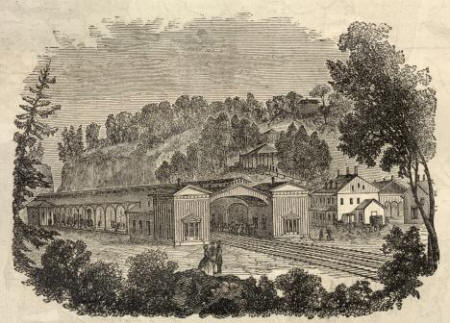 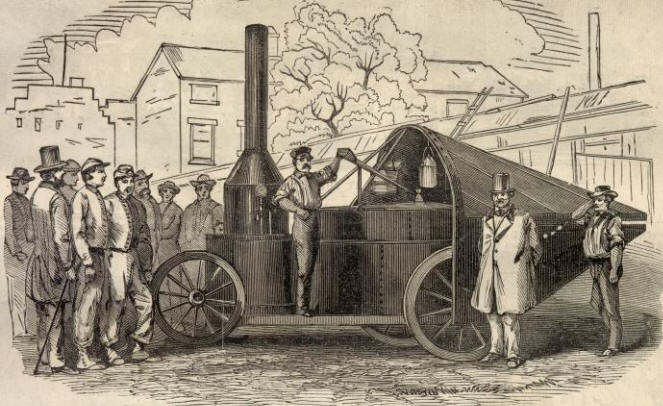 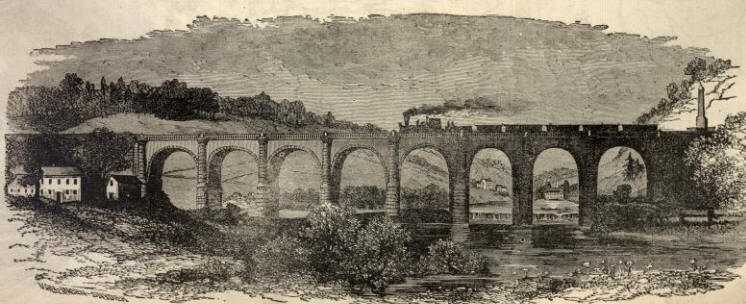 |
||||||||||||||||||||||||
|
|
||
|
|
Site Copyright 2003-2018 Son of the South. For Questions or comments about this collection, contact: paul@sonofthesouth.net |
|
|
Are you Scared and Confused? Read My Snake Story, a story of hope and encouragement, to help you face your fears. |
||
